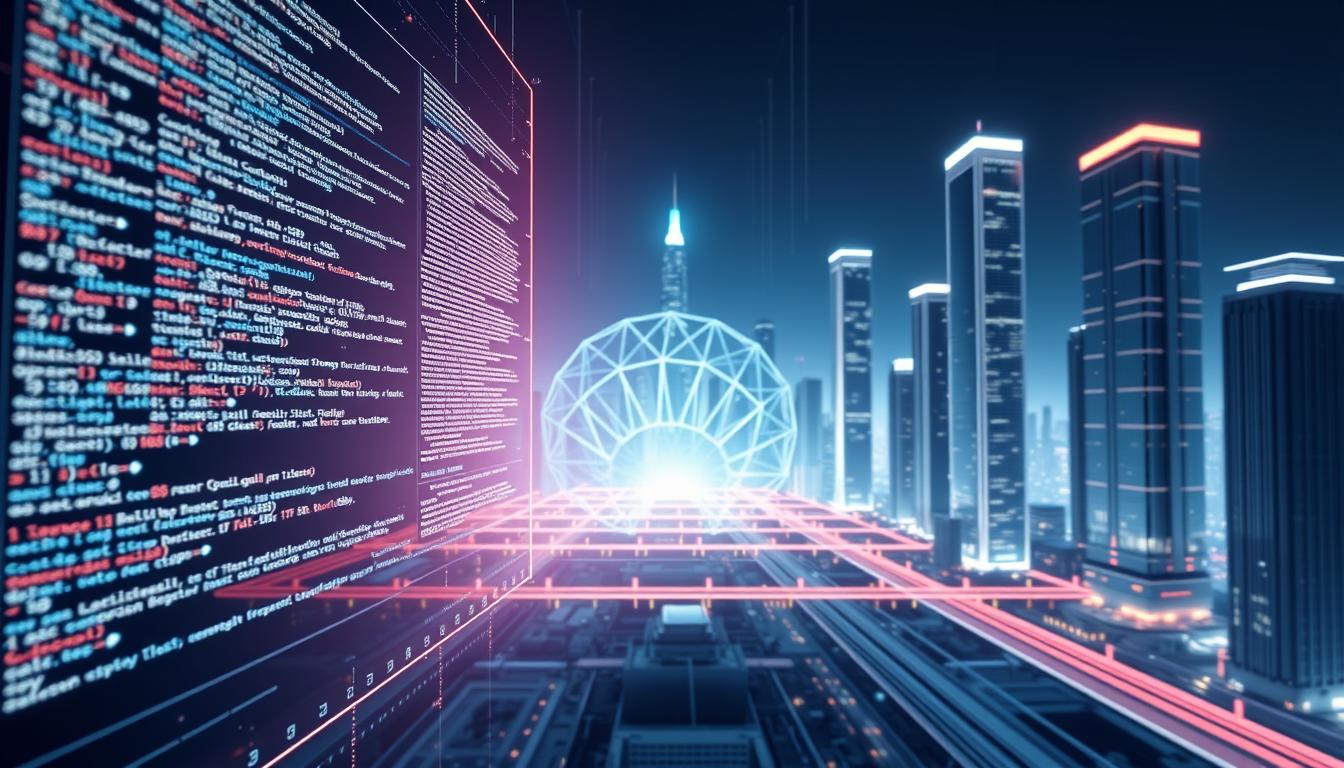Now Reading: Unlock the Power of AI x DeFi: A Comprehensive How-to Guide
- 01
Unlock the Power of AI x DeFi: A Comprehensive How-to Guide
Unlock the Power of AI x DeFi: A Comprehensive How-to Guide

The financial landscape is entering a new era of innovation. At its core lies the groundbreaking fusion of blockchain-based finance and autonomous decision-making systems. This convergence, often called DeFAI, has created a $1.3 billion ecosystem where technology reshapes how we manage assets and execute transactions.

DeFAI combines the transparency of decentralized networks with self-operating tools capable of solving complex tasks. These systems analyze data, adapt strategies, and interact with smart contracts—all without constant human oversight. Their ability to learn and iterate positions them as transformative forces in modern finance.
Market growth stems from multiple drivers. Technological advancements now enable secure, large-scale automation. Users increasingly seek streamlined solutions for trading and investments, while institutions explore ways to optimize portfolios. Regulatory frameworks are also evolving to support this technological synergy.
Key Takeaways
- DeFAI represents a $1.3 billion market merging blockchain finance with autonomous systems
- Agentic tools execute tasks through smart contracts without human intervention
- Growth drivers include tech maturity, user demand, and supportive regulations
- This shift enables accessible, intelligent financial operations for all users
- Advanced systems adapt strategies using real-time data analysis
Exploring the New Landscape of AI x DeFi
Modern financial tools are evolving through the fusion of blockchain networks and self-learning algorithms. This synergy creates three distinct layers reshaping how users interact with digital assets:

Understanding Decentralized Finance and Artificial Intelligence
Infrastructure Platforms form the backbone, handling complex tasks like model training and transaction security. These systems ensure reliable data analysis while maintaining decentralized principles. Abstraction protocols simplify interactions, letting users manage assets through voice commands or plain text.
Vertical Applications target specific needs like yield optimization. They transform traditional services into automated solutions running on transparent ledgers. This layered approach explains why user-friendly interfaces dominate: abstraction tools hold 46.6% market share across top projects.
Market Drivers and Emerging Trends
Four forces are accelerating adoption:
- Improved algorithm accuracy reducing risks
- Growing demand for self-managed portfolios
- Institutional investments in blockchain solutions
- Clearer regulations in major economies
These trends position 2025 as a potential breakthrough year. Real-time analytics and predictive tools now enable smarter decisions across lending, trading, and risk management – all operating through decentralized networks.
Technological Innovations Revolutionizing DeFi
Emerging tools are reshaping decentralized systems with intelligent automation. These advancements merge self-executing agreements with adaptive decision-making frameworks, creating autonomous financial ecosystems. At their core lie enhanced protocols that interpret market signals and execute complex operations independently.

Smart Contracts, Agentic Systems, and Automation
ChainGPT’s AI Virtual Machine demonstrates this shift. Its infrastructure allows developers to deploy customized agents across multiple blockchains, handling tasks from risk assessment to liquidity management. Griffain’s solution uses specialized networks where delegation protocols coordinate with execution modules, automating multi-step transactions securely.
Insights from Industry Pioneers
HeyAnon’s AUTOMATE framework simplifies protocol integration through condition-based triggers. Developers can monitor opportunities across markets while maintaining compliance standards. Crypto.com’s toolkit takes this further, enabling wallet management and token swaps through unified interfaces.
These platforms share three critical features:
- Modular architectures for scalable solutions
- Real-time analytics embedded in decision loops
- User-centric designs reducing technical barriers
Their innovations prove that smart automation isn’t just possible – it’s actively transforming how systems interact within decentralized environments.
Real-World Use Cases Transforming DeFi Ecosystems
Financial innovation is no longer theoretical. Practical applications now automate complex operations across decentralized networks, delivering measurable results. Below we examine how algorithmic tools reshape trading strategies and portfolio protection.
Automating Trading & Yield Farming Strategies
Algorithmic trading tools analyze price patterns across 40+ exchanges simultaneously. Platforms like Griffain enable voice-command execution for precision trades, including timed token swaps and NFT creation. These systems adjust strategies hourly based on volatility indicators.
Yield optimization reaches new heights through predictive analytics. One platform increased user returns by 63% by automating liquidity provision across pools. Users can maximize farming returns without manual calculations through smart rebalancing protocols.
Enhancing Risk Management and Portfolio Intelligence
Advanced monitoring tools now scan for 18 risk factors in real time. HeyAnon’s Gemma system tracks lending positions and automatically adjusts collateral ratios during market dips. This prevents liquidation events while maintaining yield potential.
Portfolio guardianship evolves through machine learning. Custom agents assess token performance against macroeconomic trends, suggesting reallocations when correlations weaken. These applications transform risk management from reactive to predictive – a critical shift in volatile markets.
AI x DeFi Integration: Empowering Agents and Smart Operations
Digital finance enters uncharted territory as autonomous systems handle intricate operations once requiring expert oversight. These intelligent tools now manage critical processes through self-optimizing frameworks, letting users focus on strategic goals rather than manual execution.

How AI Agents Automate Liquidity and Wallet Management
Sophisticated agents monitor market fluctuations 24/7, adjusting liquidity pools across protocols. Griffain’s Personal Agents demonstrate this capability, allowing custom rules for staking SOL or distributing tokens. Their systems:
- Rebalance assets using real-time price feeds
- Execute trades during optimal volatility windows
- Secure wallets through multi-signature protocols
Natural Language Processing and Smart Contract Execution
Conversational interfaces transform how users interact with blockchain networks. HeyAnon’s platform lets anyone command complex actions through simple phrases like “Increase ETH yield exposure.” Behind these commands:
- Language models decode user intent
- Agents verify on-chain data for accuracy
- Smart contracts trigger precise operations
Multi-agent networks now coordinate tasks ranging from token swaps to risk mitigation. This collaborative approach reduces human intervention while enabling smarter decision-making across decentralized ecosystems.
Embracing the Future: The Next Phase of AI x DeFi
The next wave of financial innovation is here, powered by intelligent systems redefining decentralized ecosystems. While still in its early stages, this fusion promises to transform how users interact with digital assets through intuitive automation and adaptive strategies.
Current platforms face challenges in differentiation, but emerging tools are streamlining access to complex protocols. Agents will soon handle tasks like wallet setup and strategy execution, turning manual processes into automated workflows. Users can expect real-time insights on yield opportunities and automated portfolio rebalancing based on market shifts.
Risks remain, including potential biases in algorithmic decisions and vulnerabilities in smart contracts. Regulatory clarity around autonomous systems continues to evolve, requiring platforms to prioritize transparent data analysis and secure infrastructure. These challenges highlight the need for balanced innovation as the ecosystem matures.
Looking ahead, future developments in decentralized finance will focus on creating self-optimizing networks. The goal? Transforming blockchain-based tools from specialized instruments into accessible solutions for managing assets and liquidity at scale.
FAQ
How do decentralized systems and machine learning work together?
Decentralized networks leverage machine learning to analyze on-chain data, optimize liquidity pools, and automate complex tasks like yield farming. Platforms like Aave use predictive models to adjust interest rates, while tools such as Chainlink integrate real-world data into smart contracts.
What trends are shaping the future of automated finance?
Key trends include agentic automation for wallet management, NLP-driven smart contract execution, and AI-powered risk assessment tools. Emerging platforms like Yearn Finance use adaptive algorithms to maximize returns, while Synthetix employs decentralized oracles for real-time market insights.
How do smart contracts improve efficiency in decentralized ecosystems?
Smart contracts enable trustless execution of trades, loans, and yield strategies without intermediaries. Combined with agentic automation, platforms like Uniswap automate liquidity provisioning, while Balancer uses dynamic algorithms to rebalance portfolios based on market conditions.
Can automation tools enhance security in decentralized applications?
Yes. Advanced analytics platforms like Gauntlet simulate market risks to optimize protocol parameters, reducing vulnerabilities. Decentralized insurance protocols such as Nexus Mutual also use predictive models to assess coverage needs and mitigate smart contract exploits.
How does natural language processing impact decentralized platforms?
NLP allows users to interact with protocols using everyday language. For example, platforms like Fetch.ai enable voice commands to execute trades or adjust liquidity positions, making decentralized finance more accessible to non-technical users.
What role do decentralized oracles play in intelligent systems?
Oracles like Band Protocol feed real-time data into machine learning models, enabling accurate predictions for yield farming or derivatives trading. This integration ensures smart contracts react to market shifts instantly, minimizing slippage and maximizing returns.














